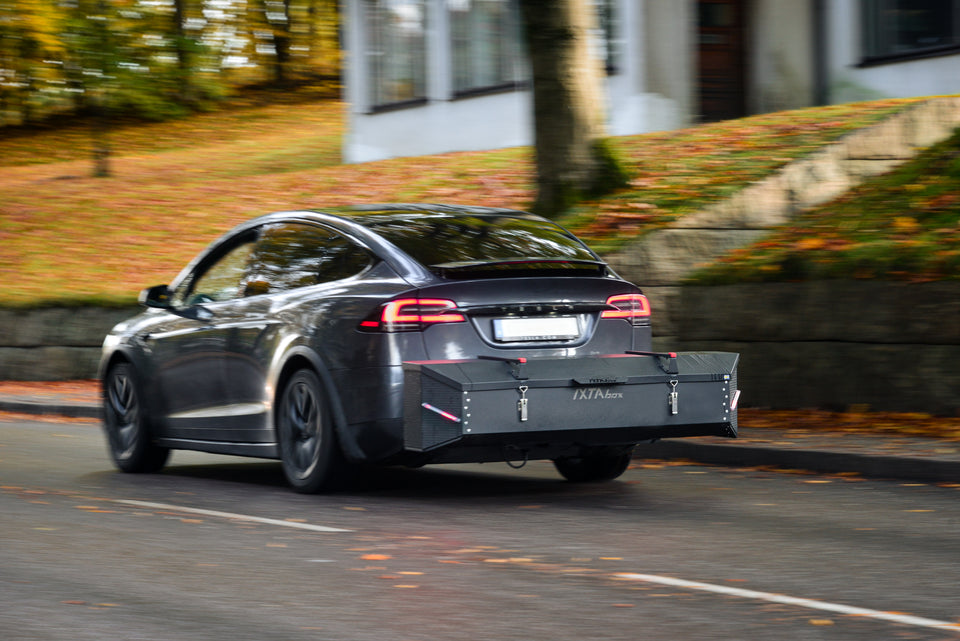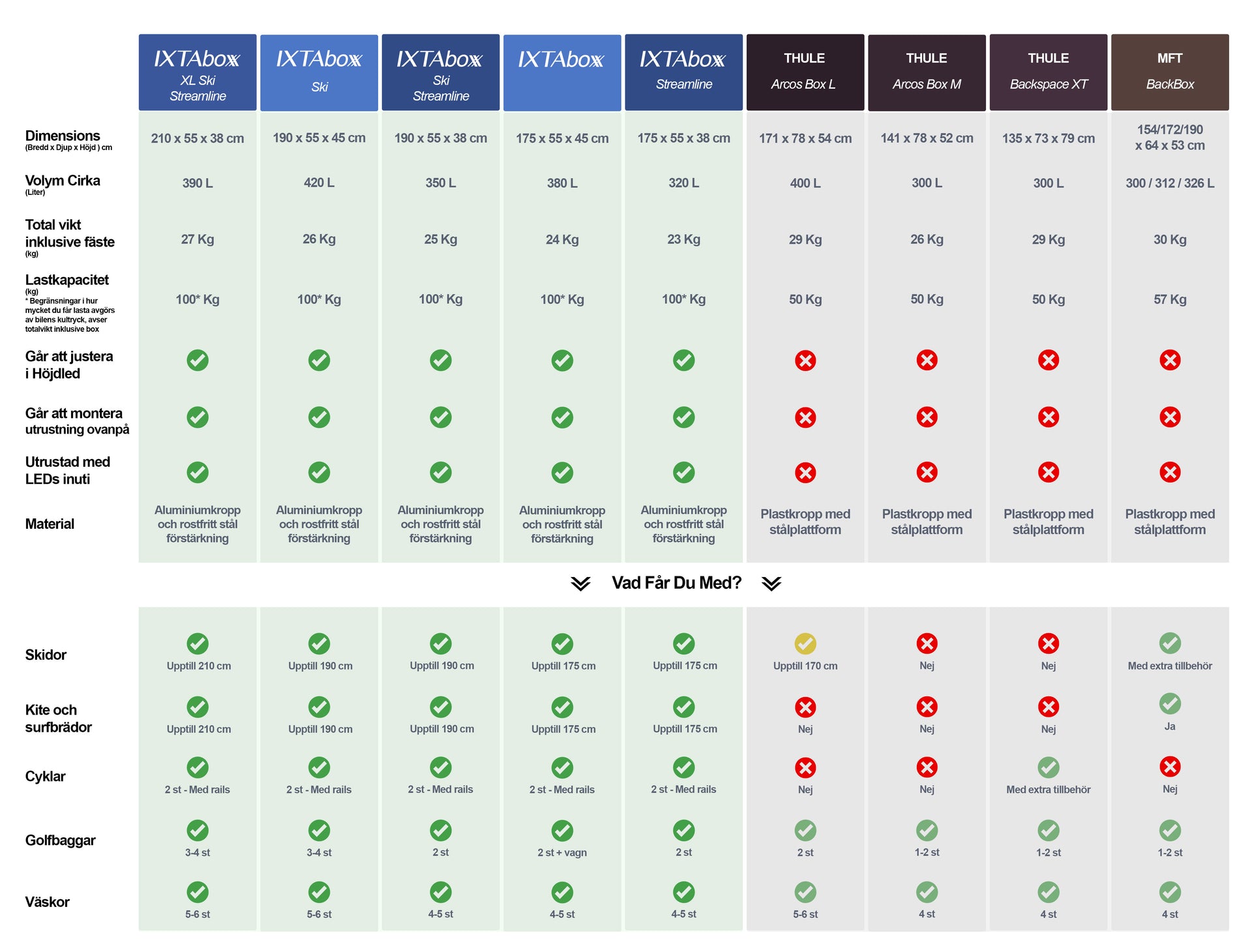The aerodynamic superiority of IXTAbox
IXTAbox is proved to have aerodynamic superiority over a roofbox, as shown in Marcus Sandberg’s Master Thesis. Sandberg's work showed an increase in drag from 3% to 15% when using IXTAbox. In contrast, rooftop boxes generated an extra drag force of 38% to 43%. Moreover, an IXTAbox correctly mounted on a vehicle lowered the total drag force compared to the vehicle alone under certain conditions, thus increasing the range of the car.

Aerodynamic Study of Vehicle Mounted Cargo Boxes
Even at first glance it is obvious that a rooftop box would generate more wind drag than an IXTAbox placed behind the vehicle. However, how much more? What are the impacts of different sizes and positions of an IXTAbox relative to the towing hook and vehicle? What things can be done to further reduce wind drag while driving?
These questions were thoroughly investigated by Marcus Sandberg in his Master Thesis at the Chalmers University of Technology during the fall and winter of 2021-22 and provided ground-breaking and fact-based evidence of the benefits of using IXTAbox over common rooftop boxes.
In this work, Sandberg used powerful computational simulation tools to compare how two differently sized rooftop boxes compare in performance to multiple IXTAbox models while driving at 90 km/h. In the case of the roofbox, a large model and a more streamlined one were tested, while six sized IXTAboxes 150, 170 and 190 cm wide that respectively are 40 and 60cm were part of the study.
To simulate the performance of each box, Computational Fluid Design (CFD) tools were used, which are also employed by auto, boat and aeroplane designers. These simulations ran on Chalmers' powerful computers and each calculation took between 12-24 hours to compute.
¿What Is Wind Drag? - An Abbreviated and Simplified Explanation of a Complex Field of Aerodynamics.
In short, drag is the force of wind or air resistance pushing in the opposite direction to the motion of the object. When an object is moving through a medium, such as air, it generates drag, which can be greater or smaller pending on the shape of the object.
The specific drag level of an object is called the Drag Coefficient Cd. When multiplied by the Projected Area of the object moving through the medium Ap, the total Drag Force Fd can be calculated. This is the force that pushes the vehicle in the opposite direction to where it is heading. This is caused by the pressure difference that the object generates while moving through the medium, similarly to the wing of a plane that creates an upward lift due to the lower pressure on top of the wing. In a car, this lower pressure is typically created behind the vehicle where a wake is formed and the air reaches almost zero velocity as shown in image 1.

The simulations were done using a digital reference model called DrivAer Notchback, which has a Cd of 0,254 and is conceptually a mixture of an Audi, BMW, Mercedes, Volvo sedan vehicle.
With the projected Area, Ap of this reference vehicle being 2.106m2, the total Drag Force created Fd is 0,536. Computing using CFD for the two roof boxes and the six variants of IXTAboxes the following results were obtained:
|
Model |
Cd |
Area (m2) |
CdA = Fd |
% Diff |
|
DrivAer Alone |
0.254 |
2.106 |
0.536 |
0% |
|
Streamlined roof box |
0.307 |
2.407 |
0.740 |
38% |
|
Volume roofbox |
0.310 |
2.472 |
0.769 |
43% |
|
150-40 IXTAbox |
0.263 |
2.106 |
0.554 |
3% |
|
150-60 IXTAbox |
0.281 |
2.106 |
0.592 |
10% |
|
170-40 IXTAbox |
0.263 |
2.106 |
0.555 |
4% |
|
170-60 IXTAbox |
0.281 |
2.108 |
0.596 |
11% |
|
190-40 IXTAbox |
0.282 |
2.152 |
0.603 |
13% |
|
190-60 IXTAbox |
0.283 |
2.183 |
0.618 |
15% |
Both roof boxes naturally increase the Projected Area (increased by 0.301-0.366m2), while only half of the IXTAbox models perceive any increase (increased by 0.002-0.077m2). Moreover, the higher Drag Coefficient Cd has a negative effect on the roof boxes, as Cd only increased slightly for the IXTAbox models.
The results conclude that the total drag force created with any variant of the IXTAbox will only increase from 3% to a maximum of 15%, while the rooftop boxes generate an extra drag force of 38% to 43%.
The impact of the drag difference is well depicted in the following comparable images, where you can see the size of the wake generated by both boxes, as well as the low-pressure zones and wind speed behind the vehicle.


*Image 2.2*
This study showed that the vertical position of the IXTAbox can also have an impact on the wind drag. An IXTAbox is preferably positioned levelled or higher than the undersurface of the car. In cases when the IXTAbox is positioned lower, the wind can flow between the car and the box, increasing wind drag to some degree (Image 4). However, under certain conditions, an IXTAbox on a vehicle can create a lower drag force than the vehicle alone.

* Image 3.*

* Image 4. Wind drag impact with low positioned IXTAbox, shows air moving between the car and the box *
This is possible as an IXTAbox can replace much of the car's natural wake and thus changing the total shape of the vehicle and box. As seen in Images 2 and 3, the shape of the box makes a “natural” prolongation of the car’s sloping shape and thus improving the aerodynamic shape altogether. When a box adds a minimal Projected Area and is well-positioned to minimize the airflow coming from the underflow between the car and the box, interesting results can be achieved. In simulations where a diffusor is extended from the bottom of the IXTAbox towards the car, thus preventing the airflow between the car and the box, wind drag is approximately 5% lower than with only the vehicle. This scenario opens the door to the possibility of using an IXTAbox to lower wind drag and this driving farther.
Wind drag impact on range and fuel consumption
Increased wind drag has a particularly high impact on driving performance for electrical vehicles and vehicles with relatively weak engines. Unfortunately, there is no one formula that can be used to calculate how fuel consumption/electricity and consequently how the range is impacted by wind drag. The reason is that drag is dependent on several factors, including the following main ones; car size in relation to the roof box and the strength of the engine.
We make two extreme examples to clarify:
Imagine a small car with a weak engine and a large roofbox, versus a large SUV that is not very aerodynamically shaped with a strong engine.
In the case of the small car with a large roofbox, the fuel consumption could increase by >50% since the combination of a larger Ap, a much worse Cd and a weak engine will consume an increased amount of fuel to make the car move forward.
In the case of the large, not very aerodynamic SUV, the percentage impact will be relatively small even with a large roof box. The Ap and Cd do increase, however, the strong (fuel-thirsty) engine absorbs the extra drag force load and the fuel consumption increase probably falls in the 5-10%. Not to forget the larger car has a much higher fuel consumption from start.
Based on literature studies and examples from people driving with roof boxes, we find that for a medium-sized car fuel consumption increases by 10-30%. With an IXTAbox the impact on fuel consumption and range is 65-75% lower compared to rooftop boxes, i.e., 2-10% pending model and car combination.
Based on my own experience having driven more than 50 000 km using a Tesla X, with mainly 190x40 and 190x60 IXTAboxes, I estimate that the added fuel consumption is in the 3-5% range. Moreover, velocity has an impact on fuel consumption and range; when driving in the 50-100 km/h range the 3-5% consumption level is maintained while it is increased at higher speeds.
As society is moving into using more and more electrical vehicles, all carmakers are developing more aerodynamic cars as it is one of the key factors to reduce fuel consumption per km.
The following example provides a clear example of how carmakers push range for smaller cars. For example, VW's new iD3 is not built to be fitted with a rooftop box, the simple fact being that this relatively small car with a modest engine, would get terrible range performance when using a roof box.
Still, the future in many ways is in the increased use of smaller cars. Many people search for a car that is easy to park and use in congested cities, however, this also means sacrificing space in the car. The solutions that IXTAbox provides can be the difference between buying a larger car to carry everything with you, versus buying a smaller car and using an IXTAbox to bring the gear along. All of this without sacrificing your range and fuel consumption.
Going forward, we believe that the increased demand for electric vehicles will call for better aerodynamics to maintain/increase range; plus, the unavoidable need to bring extra gear along with you will continue to push the demand for cargo boxes positioned behind the car.


